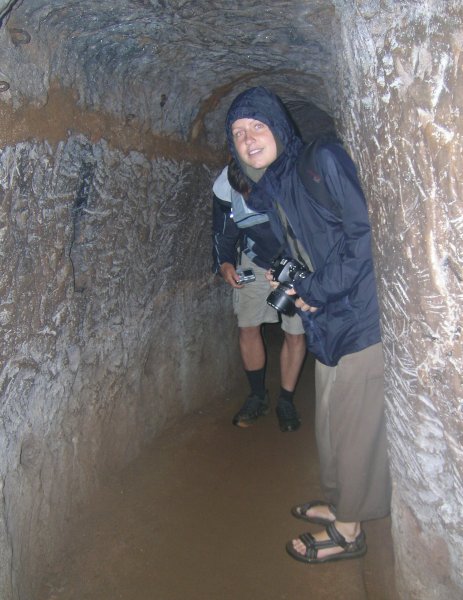
Yesterday (I'm writing on the 22nd of January, although this will be posted later) was a long and very interesting day. Three of us chose to go on a xe om (motorcycle taxi) tour of the DeMilitarized Zone (DMZ) that used to divide North and South Vietnam. It drizzled most of the day, which made the xe oms less than ideal. But it was fascinating, and while sunshine usually creates better photographic opportunities, I think the picture of the old check-point bridge across the Ben Hai River is more appropriate on a rainy day. After the country was split in half at the Ben Hai River ("temporarily," a condition that lasted more than twenty years), there was a 55 day period in which people could choose whether they wanted to live in the South or the North of the country. This is a recreation of the bridge they had to cross. The monument on the far side is new.

There are three(?) places in Vietnam where the underground tunnel-villages of the Viet Cong have been preserved, but this is the only one that hasn't been modified for easier access for tourists. There have been changes, most notably to re-enforce the entrances to prevent collapses, but the tunnels are still the incredibly claustrophobic original size carved out of clay with only marginally better lighting than they had in the late sixties when an entire village of 500 lived in here. Lu, the woman seen in the tunnel above, is 161 cm or 5'3". She could stand up straight most places, but I was crouched over almost everywhere and turning around presented a challenge with a backpack on. There were "living quarters" carved into the sides of the tunnels - holes six feet deep by five feet wide and four feet tall that would "house" five or six people. One toilet for five hundred people. All entrances disguised, many leading to a forested hillside facing the sea.

We also visited the Truong Son National Cemetery, built to honour the war dead of the North. According to our guide, the North (unlike the South) didn't use conscription, instead relying on propaganda to encourage patriotism. They also didn't restrict the age of their recruits: the dates above correspond to a birthdate of 1954, year he joined the army 1963, and year he died 1966.